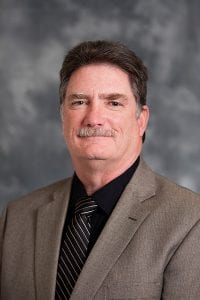The Q & A With Campus Partners series is designed to connect faculty with personnel and offices on campus in order to better serve Belmont’s students. This installment features Pat Cunningham from the Office of Campus Security.

What is your title and how long have you been at Belmont?
I came on board as Chief of Campus Security at Belmont on March 17th, St Patrick’s Day, 2014, so I’m going on 5 years at Belmont; however, I’m also a Belmont graduate and worked at the Vanderbilt University Police Department for a number of years, so I have worked with Belmont Security on a variety of cases and projects for over 30 years.
What brought you to Belmont?
A sense that I could help a good department become an exceptional department. Belmont Security has always had great staff who love Belmont, love working with students, and are committed to keeping our campus safe. Where we had opportunities to be stronger, though, was to be more effective and efficient as an organization – to direct our policies, our training, our patrol philosophy in a deliberate and intentional fashion toward operationalizing those concepts by embracing a Community Policing philosophy that drove our Vision 2020 plans.
What do you do in your role as Chief of Campus Security?
My official job description includes creating and implementing the vision and strategic plan for the Office of Campus Security to ensure a collaborative, student-centered approach that aligns with the mission, vision, and strategic plan of the institution. What that translates into on a daily basis is ensuring each and every officer, each and every shift, each and every function is focused first and foremost on the best interest and welfare of our students, on providing exceptional service to the campus community, and on continuous improvement. We oversee parking enforcement and access control. We make sure that buildings that are supposed to be locked are locked, doors that are supposed to be open are open – that lights, locks, emergency phones, cameras, and anything else related to security has been checked and is functioning properly. We monitor traffic flow and pedestrian safety, and conduct parking enforcement. And we seek to engage students and build relationships so trust is established before an incident occurs. In the past few weeks we’ve had officers participate in a dunk tank to support a sorority’s charity efforts, partnered with SGA to hand out candy (and security tips) on Halloween, and provided hot chocolate (and safety tips) at crosswalks at dusk. Most of what I do involves making sure we keep a balance so all of our responsibilities are fully and continuously met and that we have mechanisms in place to quickly identify and address any concerns that arise.
How does your office serve Belmont’s students?
Two of the most important things we do are:
- have officers focus on engaging students both so we can hear first-hand what concerns they have and so they are comfortable calling when they have issues or concerns.
- providing security education and awareness programming, whether that’s a 1 minute 1:on:1 conversation with an officer where we discuss bystander intervention, the escort system, and pedestrian safety, or a convocation on self-defense with an officer presenting to a group of 35 on personal safety.
We have 30 total staff including officers, dispatchers, and command staff which breaks down to a dispatcher, a supervisor, and 2-3 officers on patrol at any given time. While we do provide the first response to police, fire, and medical emergencies on campus, the key to keeping our campus safe is enlisting the community to develop good security habits, look out for one another, and be involved in keeping our campus safe.
In what ways do (or can) faculty partner with your office?
Communicate with Security (and our campus partners such as Res Life and FMS) on issues of concern. Whether it’s working as part of the team to follow up on a student of concern report, providing security information on Clery responsibilities or active shooter response, or following up on issues related to access control or parking, the better we do at sharing information, the better we’re able to serve our campus community
What would you like faculty to know about Campus Security?
Campus Security is here and available as a resource 24 hours a day, 7 days a week. If you are going to be working late and would like an officer to stop by to check, call Security at x6617. If you lock your keys in your car or need a jump start, call Security at x6617.
If you see something suspicious, or have a police, fire, or medical emergency call Security at x6617 or x6911. If you’ve got an issue and are just unsure who else to call, call Security at x6617 and we’ll be glad to assist.
You can find more information on the Office of Campus Security here.




